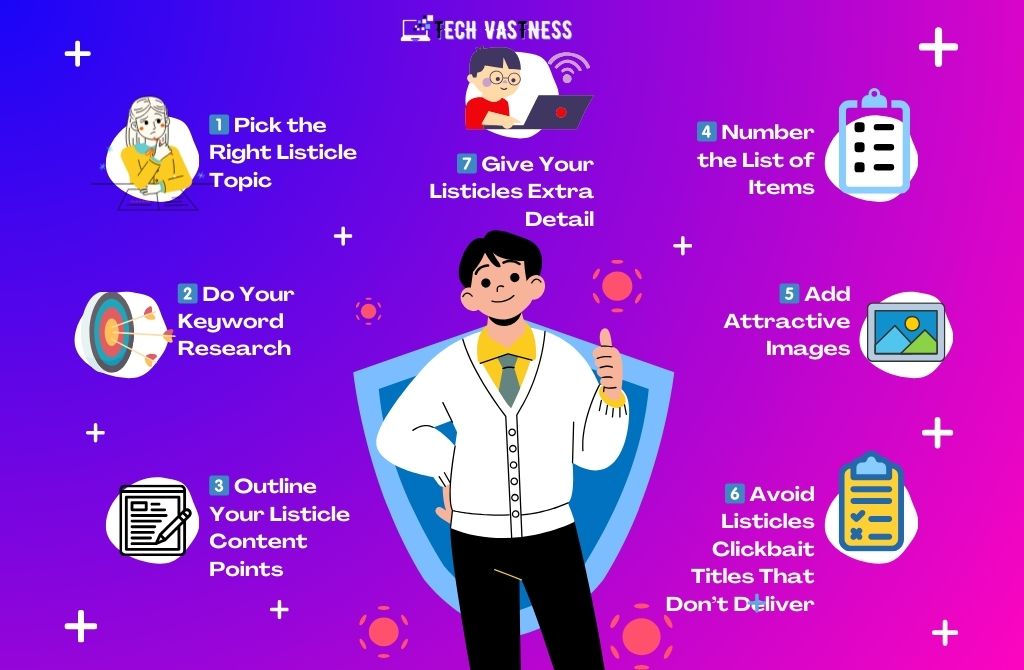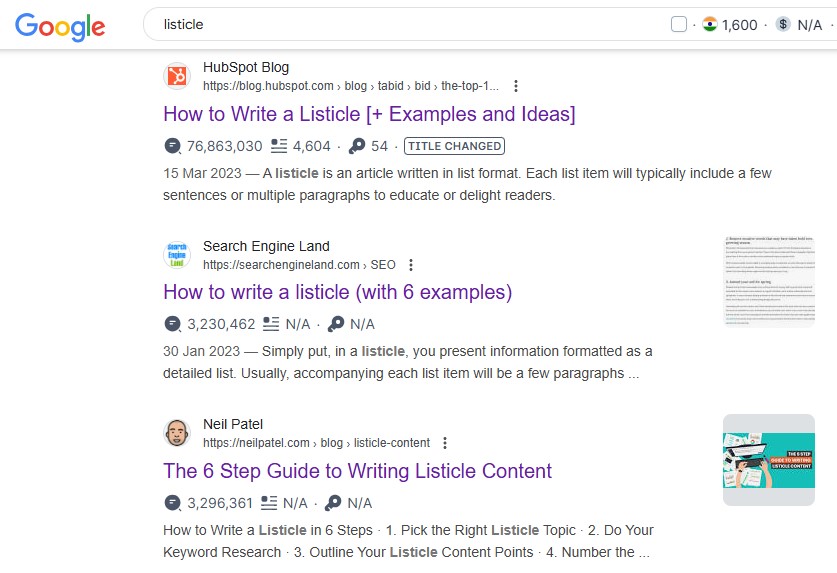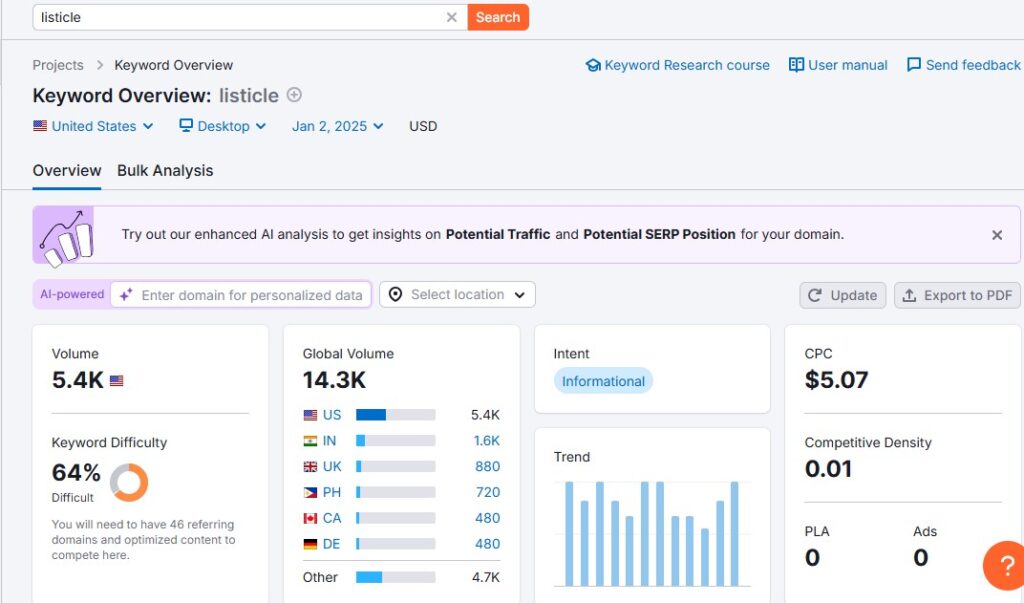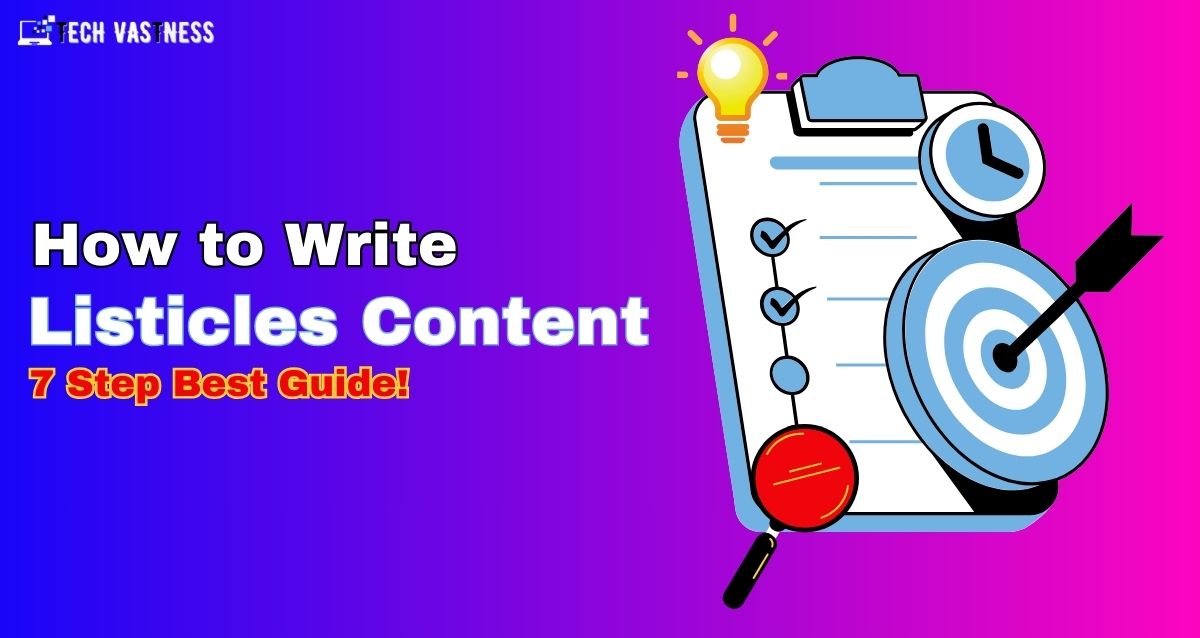If you’re looking for how to write a listicle is the right place for you. The humble listicle is one of the most famous formats for written online content.
Regardless of how you feel about listicle content, you’ve probably read several of them. Listicles present a large amount of information in small, easy-to-scan, numbered sections.
55% of bloggers say they’ve published listicle content in the last 12 months (only how-to articles rank top).
But this fame exists precisely as people love to read lists. Listicle content can cover all kinds of topics.
In this context, I’ll guide you via a few steps to create an effective list post.
I’ll also explain write listicles of why these posts are so popular and why they are critical to a successful content marketing strategy.
What are Listicles?
Easily put, it’s content made up of a list of items or ideas.
Listicles wasn’t invented by Buzzfeed, despite what you might think. It has been around for centuries.
Sei Shonagon, an 11th-century Japanese poet & lady-in-waiting, is believed to have penned the first listicle, which added gems such as her list of “Rare things” like Two people living together who regularly to be overawed by each other’s excellence.”
That being said, Buzzfeed has indeed famed listicles as online content.
For content marketers and creators, listicles are a convenient method of presenting information in bite-size portions. Producing the content becomes a bit easier, and consuming it is more enjoyable and looks so beautiful.
Why are Listicles So Popular?
Imagine coming across the following 2 topics during a Google search:
- ✅ 12 Effective Digital Marketing Tips
- ✅ How to Do Digital Marketing
Which of the 2 are you more likely to click? The first, right? The first topic promises easy-to-skim content by specifying a fixed number of tips.
With an average human attention span of about eight seconds, paying attention to one thing for very long is harder. A post that allows users to skim is far more appealing.
From the first title above, users also know what to expect within the post. They know there are just 12 tips, while the other one might be five tips or 50 pages on how to write, launch, and optimize their digital marketing.
Listicle structure, on the other hand, is quite easy. Typically there’s an introduction. This makes listicle production relatively easier compared to other types of articles.
List posts are also popular as they feed into our brain’s drive to categorize information and give us a sense of satisfaction when we correctly predict patterns.
Marketers love listicles as they get clicks. According to a study, 36% of users prefer titles with numbers over any other title type.
😱 Types of listicles
Here’s a list of a few of the most popular types of listicles.
️⃣ #️⃣ 1: Informational
These are the knowledge pieces of the listicle world, packed with statistics, facts, and insights presented clearly and concisely. Think of them as mini-documentaries broken down into bite-sized nuggets. Some instances of informal listicles are:
- “10 Fascinating Facts About the Human Heart”
- “6 Steps to a Perfect Smoothie”
- “The History of Tea in 7 Sips.”
#️⃣ 2: Recommendation
Can’t decide what to watch, read, or purchase? These listicles come to the help, offering curated selections of great options based on specific criteria. They cover everything from must-try restaurants to top travel destinations, they’ll help you make informed choices. Some instances of recommendation listicles are:
- “12 Books to Read Before You Turn 30”
- “The 9 Gadgets That Will Make Your Life Easy”
- “Top 13 Hiking Trails for Beginners.”
#️⃣ 3: How-To
Must a quick guide on how to tie a tie, fix a leaky faucet, or bake the perfect bread? Read how-to listicles because they break down complex tasks into simple, step-by-step instructions, making them ideal for visual learners and anyone looking for a practical cheat sheet. Some instances of how-to listicles are:
- “5 Easy DIY Crafts for Home”
- “10 Tips for Taking Better Mobile Photos”
- “How to Make Rasmalai at Home.”
#️⃣ 4: Entertaining
Laughter is the best medicine, and these listicles are filled with hilarious anecdotes, witty observations, and funny memes. They’ll have you chuckling from beginning to finish. Some instances of entertaining listicles are:
- “20 Signs You’re a Cat Person”
- “The 12 Most Awkward Celebrity Encounters”
- “Things You Didn’t Know About Your Eagle (But You Know Should).”
#️⃣ 5: Controversial
These listicles stir the pot, presenting unfame opinions, challenging conventional wisdom, and sparking debate so be prepared for a few heated discussions if you delve into these! Some instances of controversial listicles are:
- “13 Things You Should Never Say to Millennials”
- “The 6 Most Overhyped Tourist Attractions”
- “Reasons Why Winter Are Better Than Summer.”
How to Use Listicles in Your Content Marketing
As listicles have had a poor reputation, you might be hesitant to use them in your content marketing strategy. The real truth is, that list posts can be as helpful and informative as prose, provided the content is high quality.
For example, I built this listicle about how to use Instagram in marketing. It is in a listicle format but still offers valuable information marketers can use to drive traffic & increase brand awareness.
Content marketing’s purpose is to attract and retain users. Listicles can help you achieve this goal and create an effective content marketing strategy.
Here are some ways to leverage listicles’ power to drive clicks, and traffic, and build brand awareness.
- Make a complex topic simple to understand by breaking it down into manageable parts, like “Six Things Everyone Should Know About Swim Physics.”
- Build a step-by-step guide about a topic. (Such as I am doing here.)
- Share a unique angle about a popular topic, such as “29 Awesome Ways of Repurposing Content,” which goes beyond the standard advice of turning a blog post into a podcast or creating an ebook out of several listicles.
- Compare tools or suggestions, such as “12 Online Marketing Tools You Need When Begining a Business.”
- Listicles can also be used as lead magnets to grow your email list, to share expert advice, or as a method to expand your brand’s social media presence.
How to Write Listicles

Now that you understand the strength of listicles, let’s discuss how to write listicles effectively that will drive traffic.
1️⃣ Pick the Right Listicle Topic
This is important. If your topic doesn’t fit a list format, it won’t earn as many clicks.
A few topics naturally fit into a list. For instance, how-to guides can be broken down into distinct steps:
Blog posts consisting of a list of examples make the best listicles:
What if your content is a narrative? Can you make a listicle from that?
You’d have to be pretty creative to write a narrative because a listicle doesn’t lend itself to that style of writing. That said, it’s possible.
Another method to determine whether your topic can be a listicle is by doing an easy Google search of your target keyword.
You suppose a number of the high-ranking posts for your keyword are listicles. In that case, it’s the best indication that users expect or prefer a list format to tackle the topic:

Another great place to look is your own Google Analytics data. If you see that a specific topic gets more traffic, then it might do well as a listicle if you can easily simplify the content.
For example, I know that the listicle topic gets, 5.4k searches a month, according to Semrush. Since it’s already a famous topic, it might be the best choice to create a listicle around.

2️⃣ Do Your Keyword Research
If the reason you’re so keen on building listicles is to boost your content marketing, research keyword has to be on your to-do list.
Keywords are the terms users type into a search engine to get information on a particular topic. They’re also these words Google and other search engines use to identify your post’s or web page’s focus.
When you optimize your content for particular keywords, your page is ton likely to rank and appear as an option when people search for those terms.
You can use free tools to do keyword research like Google Keyword Planner, Ubbersuggest, and Semrush.
While you’re at it, look out for long-tail keywords, as listicles are good for targeting these valuable terms.
If you want to deeper into keyword research, you can check out this blog post. ⏬
📖 How to Research Keywords: Start to Last Practical Guide!
3️⃣ Outline Your Listicle Content Points
So far, you’ve selected your topic and target keyword. Now let’s get into the listicle content.
Begin by checking out your competitor. You’ll most likely notice some common topics. Look for any gaps or weaknesses in your competitors’ content.
For instance, while building this listicle, I took a look at what’s already been written about listicles:

There are many posts about how to write a listicle. You have found any missing steps in the articles, and we already know that listicles get more clicks. That means there’s an opportunity for me to build better content than what everybody else has already published.
Next, brainstorm and jot down any steps you think would be relevant to your listicle. Then go through all the steps you’ve written down. If they would be presented well in a particular order, organize them accordingly, and merge any redundant steps. Split up any items that may be too weighty for just one point and try to make them different steps.
Looking at “People also ask” questions in Google, these are questions that people commonly search for about the same topic. They’re an easier way to ensure you’re converting the topic thoroughly.

Flesh out every post by including examples that display why each item in your numbered list was added or how to do it if you are creating a step-by-step guide. For instance, this listicle on How to Increase Domain Authority provides an example of different domain
authority and talks about why they work.
As you write your content, link to more in-depth information when essential, but ensure you don’t link to blog posts trying to rank for the same keywords. It creates more informative content without making your blog posts too long.
4️⃣ Number the List of Items
You don’t have to use lists to create listicles, it creates a good user experience. As users go through the readers, moving down the numbered list creates a sense of progress. There’s also a feeling of accomplishment, which motivates users to keep reading. It also makes sense to number the items if you use a number in the blog post title.
For lengthy list posts, numbers can make it easy for users to keep track of their progress. They can even stop reading and simply pick up later where they left off.
Numbering is also helpful when a person wants to share or reference specific points. It’s easy to refer to a particular number rather than describing a section in the post.
How many points should use though? A round number such as 10 is easier to remember. However, odd numbers are ton eye-catching and tend to pique the reader’s interest.
The reality is, that there’s no right or wrong number to add to your listicles, it depends on the topic and your competitors.
If all the other articles are 10 points long, it might be great to have even more, such as 20 or 25. On the other hand, if most other listicles in your niche are long, a short, snappy post might do well.
Whatever route you go, aim to grab users’ attention by standing out.
5️⃣ Add Attractive Images
How to write a listicle with attractive images. It’s challenging to sustain the user’s attention with just a wall of text, numbered or not. Images make your post ton visually stimulating, making them a necessary ingredient in successful listicles. They improve the content’s credibility and help to increase traffic.
Images or gifs capture users’ attention in a way plain text can’t. Instances – people follow instructions that add pictures 323% greater than written words alone. Posts with relevant images get 94% more views than those without pictures.
Buzzfeed makes great use of this tactic. Most of their article add numerous images. You can’t help but scroll on to view one after the other.
Make sure the images you choose are relevant to the content. Filling your article with unnecessary images includes no value and may result in a higher bounce rate.
Selecting images to add to your listicle, custom images are ideal. For instance, if your post involves reviewing products, you can add images of those products.
If custom photos aren’t possible, you can seek free images online on Pixabay, Unsplash, and Freepik, among others.
6️⃣ Avoid Listicles Clickbait Titles That Don’t Deliver
This may seem contradictory since I wrote another post about creating clickbait titles. Before you pounce on my controversial statement, let’s make this clear: clickbait isn’t inherently bad.
Shoddy titles that promise but don’t deliver will drive readers away. Intriguing titles that pique curiosity and drive clicks are energetic.
Does your listicle’s title promise something you don’t deliver in the body of the post? Are the claims in the title unrealistic or untrue?
If the true answer to either of these questions is “yes,” your headline is most likely the decried clickbait title, and you may want to avoid it. Listicles has a bad reputation for being clickbait.
Sensational headlines may mislead users, spoil your blog’s reputation, and hurt your content marketing in the long run. Great titles that deliver what they promise can effectively attract users.
7️⃣ Give Your Listicles Extra Detail
Most listicles don’t add very much detail. It’s not always a bad thing.
Sometimes people just want to scan a short list soon.

But if you want your listicles to stand out, attract attention, and rank in Google, I highly recommend including a few pieces of content underneath each item on your list.
For example, the Expanded List Post is not quite as easy to scan… but adds much more detail than a regular list post.

Hence, when you include detailed content for each item, your content has the great of both worlds: it presents multiple tips or pieces of information in a single post. And is typically more useful to users than a basic, shortlist post.
The exact type of detail you include depends on your topic.
But here are some details you can include in your listicle items to beef them up a little bit.
✅ Actionable steps
✅ Screenshots
✅ Extra context
✅ Examples
✅ Visualizations
✅ Video tutorials
✅ Infographics
😆Listicles Tips and Advanced Strategies
Make Your Listicles 10x Better than the Competitor
Do what you can to make your listicles a piece of “10x Content”.
Make it longer and ton comprehensive than the competitor, give it all the extra details I mentioned above, and give it a professional design.
There’s no reason listicles can’t blow readers away.
Include Filters
You include filters in your listicles to make it easy for someone to find what they’re looking for.
Add the Number of Items in Your Title
Whenever it makes sense, add the number of list items in your blog post headline.
That way, potential users have a solid idea of what your list post will look like.
Audit Your Competitors’ Backlinks
Once your list post is live, use a tool such as Semrush’s Backlink Gap to see who links to your competitors’ content but not to yours. Then, contact them to tell them about your listicle content.
Build an Outreach Campaign
Reach out to people you mentioned or linked to in your list post. It doesn’t guarantee they’ll share it.
But it gets your content in front of people in a non-pushy method.
Experiment with Content Formats
Listicles are the best way to engage your audience. However, it’s crucial to experiment with various content formats to attract readers at every stage of the customer journey.
Learn multiple types of content marketing that will help you engage, convert, and retain your audience—from videos to white papers.
How to Create a Listicle FAQ
What is the purpose of listicles?
Listicles curate—they present complicated information in a format that is easier for the brain to digest. Reading larger blocks of text is also taxing on the brain, requiring tons of energy and focus. Listicles provide a mental reprieve because the brain has to work less hard to process them.
How to write the best listicle?
Find a topic your audience will likely be interested in that makes sense in a list format. Research what listicles are already out there, then aim to create a longer or more in-depth version.
What are examples of listicles?
Listicles organize information in a way that is easier to skim and digest. Using numbers provides a sense of order and lends a logical framework to the blog post. For example, compare these examples of listicles: “12 tips to increase your Instagram followers”.
Conclusion
New content marketing strategies crop up daily. The only constant is high-quality content. Smart digital marketers understand the significance of high-quality content that’s optimized for search engines and valuable to users.
No matter the format, the best content can help generate search traffic & leads. List posts can offer the great of both worlds: easy-to-write structure and quality content that turns browsers into users.
Have you written listicles recently? Do you take any other steps to produce listicles?

